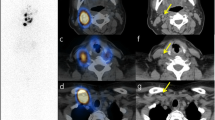Abstract
Background
The utility of integrated single-photon emission computed tomography/computed tomography (SPECT/CT) in children and young adults with differentiated thyroid carcinoma is incompletely studied.
Objective
To determine the value of adding SPECT/CT to conventional whole-body scintigraphy in post-ablation iodine-131 (131I) scintigraphy for children and young adults with differentiated thyroid carcinoma.
Materials and methods
Planar scintigraphy and SPECT/CT were performed on 42 post-surgical children and young adults (32 female, 10 male; mean age 14.3±4.9 years, range 7–20 years) with differentiated thyroid carcinoma (39 papillary, 2 follicular, 1 mixed) 5 days after the therapeutic administration of 1.9–7.4 GBq of 131I. Planar and SPECT/CT images were interpreted independently, and sites of uptake were categorized as positive or equivocal with respect to thyroid bed, lymph node and distant metastasis uptake. An experienced thyroid endocrinologist used a combination of surgical histopathology and scintigraphic findings to determine whether the addition of SPECT/CT would change patient management.
Results
Planar scintigraphy evidenced 88 radioiodine-avid foci and SPECT/CT confirmed all foci. No additional foci were disclosed by SPECT/CT. SPECT/CT correctly classified 16/88 (18%) foci that were unclear or wrongly classified at planar scintigraphy. Globally, SPECT/CT showed an incremental value over planar scintigraphy in 9 (21.4%) patients and changed therapeutic management in 3 (7.1%; 95% confidence interval, 2–20%) patients.
Conclusion
SPECT/CT improved localization and characterization of focal 131I uptake on post-ablation whole-body scintigraphy in children and young adults with differentiated thyroid carcinoma. Further prospective evaluation in a larger series is justified to prove the effect of post-ablation SPECT/CT-based management decisions.



Similar content being viewed by others
References
Bernier MO, Withrow DR, Berrington de Gonzalez A et al (2019) Trends in pediatric thyroid cancer incidence in the United States, 1998-2013. Cancer 125:2497–2505
Qian ZJ, Jin MC, Meister KD et al (2019) Pediatric thyroid cancer incidence and mortality trends in the United States, 1973-2013. JAMA Otolaryngol Head Neck Surg 145:617–623
Francis GL, Waguespack SG, Bauer AJ et al (2015) American Thyroid Association guidelines task force. Management guidelines for children with thyroid nodules and differentiated thyroid cancer. Thyroid 25:716–759
Liu L, Zhang X, Tian T et al (2020) Prognostic value of pre-ablation stimulated thyroglobulin in children and adolescents with differentiated thyroid cancer. Thyroid 30:1017–1024
Liu L, Huang F, Liu B et al (2018) Detection of distant metastasis at the time of ablation in children with differentiated thyroid cancer: the value of pre-ablation stimulated thyroglobulin. J Pediatr Endocr Met 31:751–756
Zhang X, Liu L, Chen Y et al (2020) Prognostic value of post-ablation 131I scintigraphy in children with thyroid cancer. Head Neck 42:1738–1745
Liu B, Chen Y, Jiang L et al (2017) Is post-ablation whole body 131I scintigraphy still necessary in intermediate-risk papillary thyroid cancer patients with pre-ablation stimulated thyroglobulin < 1 ng/mL? Clin Endocrinol 86:134–140
Avram AM (2012) Radioiodine scintigraphy with SPECT/CT: an important diagnostic tool for thyroid cancer staging and risk stratification. J Nucl Med 53:754–764
Nadel HR (2014) SPECT/CT in pediatric patient management. Eur J Nucl Med Mol Imaging 41:S104–S114
Israel O, Pellet O, Biassoni L et al (2019) Two decades of SPECT/CT — the coming of age of a technology: an updated review of literature evidence. Eur J Nucl Med Mol Imaging 46:1990–2012
Barwick TD, Dhawan RT, Lewington V (2012) Role of SPECT/CT in differentiated thyroid cancer. Nucl Med Commun 33:787–798
Schmidt D, Szikszai A, Linke R et al (2009) Impact of 131I SPECT/spiral CT on nodal staging of differentiated thyroid carcinoma at the first radioablation. J Nucl Med 50:18–23
Grewal RK, Tuttle RM, Fox J et al (2010) The effect of posttherapy 131I SPECT/CT on risk classification and management of patients with differentiated thyroid cancer. J Nucl Med 51:1361–1367
Mustafa M, Kuwert T, Weber K et al (2010) Regional lymph node involvement in T1 papillary thyroid carcinoma: a bicentric prospective SPECT/CT study. Eur J Nucl Med Mol Imaging 37:1462–1466
Blum M, Tiu S, Chu M et al (2011) I-131 SPECT/CT elucidates cryptic findings on planar whole-body scans and can reduce needless therapy with I-131 in post-thyroidectomy thyroid cancer patients. Thyroid 21:1235–1247
Maruoka Y, Abe K, Baba S et al (2012) Incremental diagnostic value of SPECT/CT with 131I scintigraphy after radioiodine therapy in patients with well-differentiated thyroid carcinoma. Radiology 265:902–909
Zilioli V, Peli A, Panarotto MB et al (2017) Differentiated thyroid carcinoma: incremental diagnostic value of 131I SPECT/CT over planar whole body scan after radioiodine therapy. Endocrine 56:551–559
Spanu A, Nuvoli S, Gelo I et al (2018) Role of diagnostic 131I SPECT/CT in long-term follow-up of patients with papillary thyroid microcarcinoma. J Nucl Med 59:1510–1515
Liu B, Servaes S, Zhuang H (2018) SPECT/CT MIBG imaging is crucial in the follow-up of the patients with high-risk neuroblastoma. Clin Nucl Med 43:232–238
Liu B, Zhuang H (2013) Intense iodine activity caused by mosquito bite. Clin Nucl Med 38:e414–e416
Kim HY, Gelfand MJ, Sharp SE (2011) SPECT/CT imaging in children with papillary thyroid carcinoma. Pediatr Radiol 41:1008–1012
Kiratli PÖ, Tuncel M, Bar-Sever Z (2016) Nuclear medicine in pediatric and adolescent tumors. Semin Nucl Med 46:308–323
Markovina S, Grigsby PW, Schwarz JK et al (2014) Treatment approach, surveillance, and outcome of well-differentiated thyroid cancer in childhood and adolescence. Thyroid 24:1121–1126
Acknowledgments
This work was supported by the Science and Technology Fund of Sichuan Province (grant 19ZDYF1737).
Author information
Authors and Affiliations
Corresponding author
Ethics declarations
Conflicts of interest
None
Additional information
Publisher’s note
Springer Nature remains neutral with regard to jurisdictional claims in published maps and institutional affiliations.
Rights and permissions
About this article
Cite this article
Jiang, L., Xiang, Y., Huang, R. et al. Clinical applications of single-photon emission computed tomography/computed tomography in post-ablation 131iodine scintigraphy in children and young adults with differentiated thyroid carcinoma. Pediatr Radiol 51, 1724–1731 (2021). https://doi.org/10.1007/s00247-021-05039-2
Received:
Revised:
Accepted:
Published:
Issue Date:
DOI: https://doi.org/10.1007/s00247-021-05039-2




